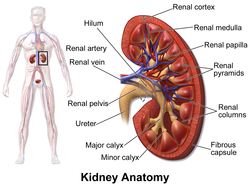| Kidneys | |
|---|---|
 The kidneys lie in the retroperitoneal space behind the abdomen, and act to filter blood to create urine | |
 Location of kidneys with associated organs (adrenal glands and bladder) | |
| Details | |
| System | Urinary system and endocrine system |
| Artery | Renal artery |
| Vein | Renal vein |
| Nerve | Renal plexus |
| Identifiers | |
| Latin | ren |
| Greek | νεφρός (nephros) |
| MeSH | D007668 |
| TA98 | A08.1.01.001 |
| TA2 | 3358 |
| FMA | 7203 |
| Anatomical terminology | |
In humans, the kidneys are two reddish-brown bean-shaped blood-filtering organs[1] that are a multilobar, multipapillary form of mammalian kidneys, usually without signs of external lobulation.[2][3] They are located on the left and right in the retroperitoneal space, and in adult humans are about 12 centimetres (4+1⁄2 inches) in length.[4][5] They receive blood from the paired renal arteries; blood exits into the paired renal veins. Each kidney is attached to a ureter, a tube that carries excreted urine to the bladder.
The kidney participates in the control of the volume of various body fluids, fluid osmolality, acid-base balance, various electrolyte concentrations, and removal of toxins. Filtration occurs in the glomerulus: one-fifth of the blood volume that enters the kidneys is filtered. Examples of substances reabsorbed are solute-free water, sodium, bicarbonate, glucose, and amino acids. Examples of substances secreted are hydrogen, ammonium, potassium and uric acid. The nephron is the structural and functional unit of the kidney. Each adult human kidney contains around 1 million nephrons, while a mouse kidney contains only about 12,500 nephrons. The kidneys also carry out functions independent of the nephrons. For example, they convert a precursor of vitamin D to its active form, calcitriol; and synthesize the hormones erythropoietin and renin.
Chronic kidney disease (CKD) has been recognized as a leading public health problem worldwide. The global estimated prevalence of CKD is 13.4%, and patients with kidney failure needing renal replacement therapy are estimated between 5 and 7 million.[6] Procedures used in the management of kidney disease include chemical and microscopic examination of the urine (urinalysis), measurement of kidney function by calculating the estimated glomerular filtration rate (eGFR) using the serum creatinine; and kidney biopsy and CT scan to evaluate for abnormal anatomy. Dialysis and kidney transplantation are used to treat kidney failure; one (or both sequentially) of these are almost always used when renal function drops below 15%. Nephrectomy is frequently used to cure renal cell carcinoma.
Renal physiology is the study of kidney function. Nephrology is the medical specialty which addresses diseases of kidney function: these include CKD, nephritic and nephrotic syndromes, acute kidney injury, and pyelonephritis. Urology addresses diseases of kidney (and urinary tract) anatomy: these include cancer, renal cysts, kidney stones and ureteral stones, and urinary tract obstruction.[7]
The word “renal” is an adjective meaning “relating to the kidneys”, and its roots are French or late Latin. Whereas according to some opinions, "renal" should be replaced with "kidney" in scientific writings such as "kidney artery", other experts have advocated preserving the use of "renal" as appropriate including in "renal artery".[8]
- ^ "Kidneys: Anatomy, Function, Health & Conditions". Cleveland Clinic. Archived from the original on 2023-06-29. Retrieved 2023-07-13.
- ^ Zhou, Xin J.; Laszik, Zoltan G.; Nadasdy, Tibor; D'Agati, Vivette D. (2017-03-02). Silva's Diagnostic Renal Pathology. Cambridge University Press. p. 19. ISBN 978-1-316-61398-6. Archived from the original on 2023-04-04. Retrieved 2023-08-16.
- ^ Haschek, Wanda M.; Rousseaux, Colin G.; Wallig, Matthew A.; Bolon, Brad; Ochoa, Ricardo (2013-05-01). Haschek and Rousseaux's Handbook of Toxicologic Pathology. Academic Press. p. 1678. ISBN 978-0-12-415765-1.
- ^ Lote CJ (2012). Principles of Renal Physiology, 5th edition. Springer. p. 21.
- ^ Mescher AL (2016). Junqueira's Basic Histology, 14th edition. Lange. p. 393.
- ^ Lv JC, Zhang LX (2019). "Prevalence and Disease Burden of Chronic Kidney Disease". Renal Fibrosis: Mechanisms and Therapies. Advances in Experimental Medicine and Biology. Vol. 1165. pp. 3–15. doi:10.1007/978-981-13-8871-2_1. ISBN 978-981-13-8871-2. PMID 31399958. S2CID 199519437.
- ^ Cotran RS, Kumar V, Fausto N, Robbins SL, Abbas AK (2005). Robbins and Cotran pathologic basis of disease. St. Louis, MO: Elsevier Saunders. ISBN 978-0-7216-0187-8.
- ^ Kalantar-Zadeh K, McCullough PA, Agarwal SK, Beddhu S, Boaz M, Bruchfeld A, et al. (June 2021). "Nomenclature in nephrology: preserving 'renal' and 'nephro' in the glossary of kidney health and disease". Journal of Nephrology. 34 (3): 639–648. doi:10.1007/s40620-021-01011-3. PMC 8192439. PMID 33713333.